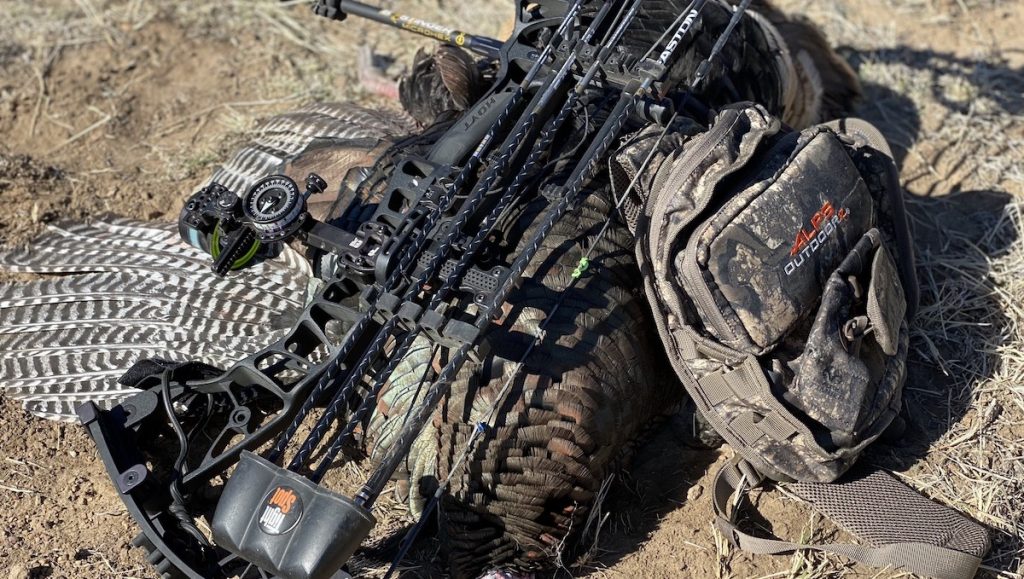Bowhunting longbeards with a bow and arrow is challenging enough; make it easier by choosing the right arrow, broadhead, and vane combo.
by Jace Bauserman
Wild turkeys may be tailored to be shot in the dome with a load of #5s, but they are fun to chase with archery tackle. Not to mention, in many states, stick-and-string toters get the first crack at these springtime butterballs. Tags, even for non-residents, are affordable, and generally, there are no preference or bonus points needed to hunt turkeys.
The main reason I love chasing these birds with a bow is the challenge. Calling a wild turkey into bow range is no easy job, and once that bird reads the script and falls for the blind-and-decoy, bow-mounted decoy, or outside-the-blind ambush, your accuracy has to be exceptional.
I don’t have the data, but I’d argue that bowhunters lose more turkeys each spring than most all other game animals combined.
Why?
The margin of error is minimal, and bowhunters take too long shots on a tiny target with hard-to-decipher vitals. Precision is paramount when hunting wild turkeys, and you want an uber-accurate arrow with some weight to it tipped with a large, expandable broadhead.
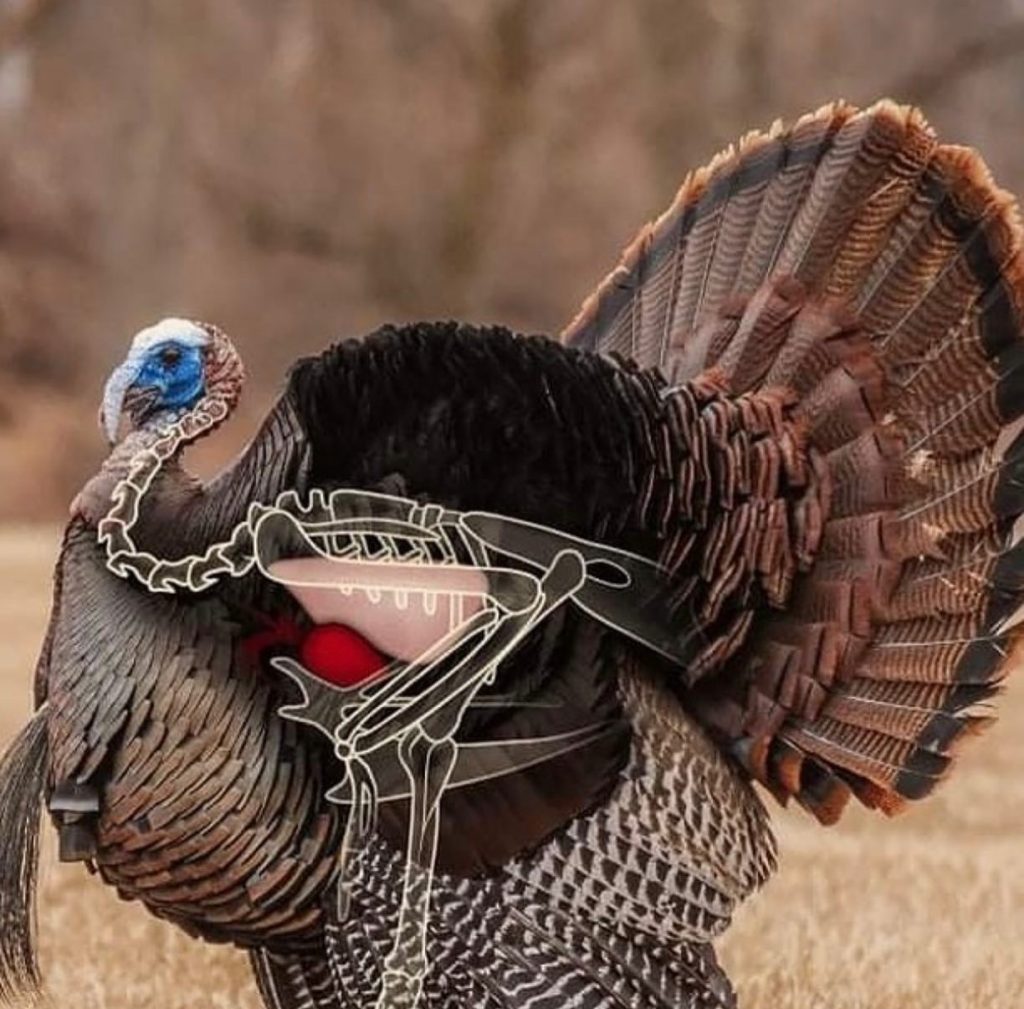
For the past several years, my go-to for archery turkey hunting has been Easton’s 4mm Full Metal Jacket, AAE Hybrid 23 vanes, and SEVR’s Titanium 2.0 broadheads.
Let’s discuss my arrow choice first. No, you don’t need a micro-diameter arrow to bowhunt turkeys with; I filled my quiver with Easton’s 5MM FMJs for years. However, I like the 4MM for big game, and I don’t believe there is a more accurate arrow on the planet. The 4MM cuts the wind like butter and tracks seamlessly behind a large-cut expandable, reducing friction as it passes through the target. Weighing 482-grains, my Hoyt VTM 31, set at a draw length of 29 inches and a draw weight of 65 pounds (for turkeys), pushes these arrows at 274 fps. When you crunch the numbers, that’s 80.34 foot-pounds of kinetic energy, which is enough to blow through a moose, let alone a turkey. Plus, when you shoot a heavy, micro-diameter arrow, you get exceptional accuracy, penetration, and tranquil arrow flight.
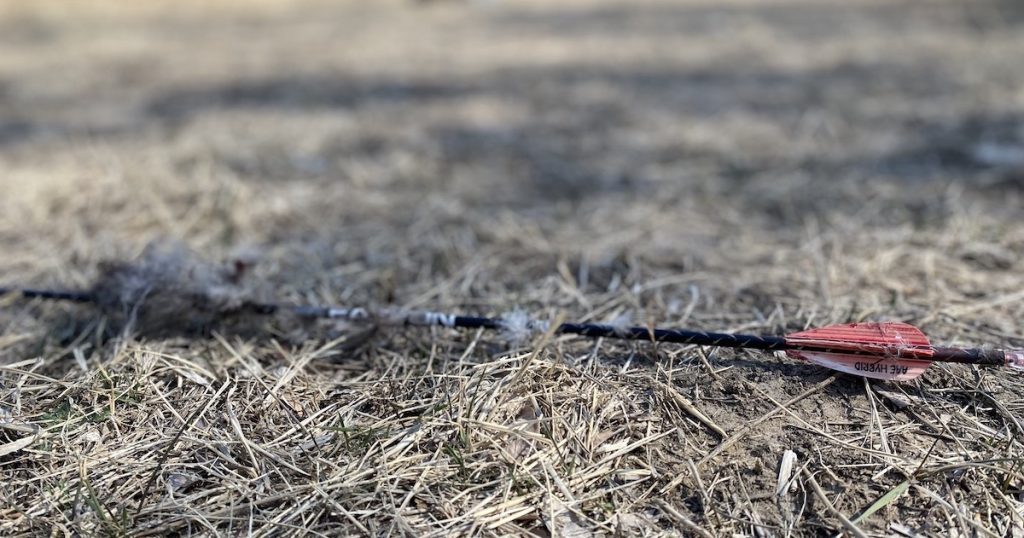
Now for my broadhead, SEVR’s Titanium 2.0. Make no mistake; there are some great broadheads on the market, and if you don’t run a SEVR, OK, please just don’t thread a fixed blade into your arrow’s insert when turkeys are on the menu. Turkeys are thin-skinned and have hollow bones, and with a kill zone that’s a little smaller than the size of a softball, a large-cutting expandable can clean up an errant shot. You want your broadhead to cause as much damage as possible.
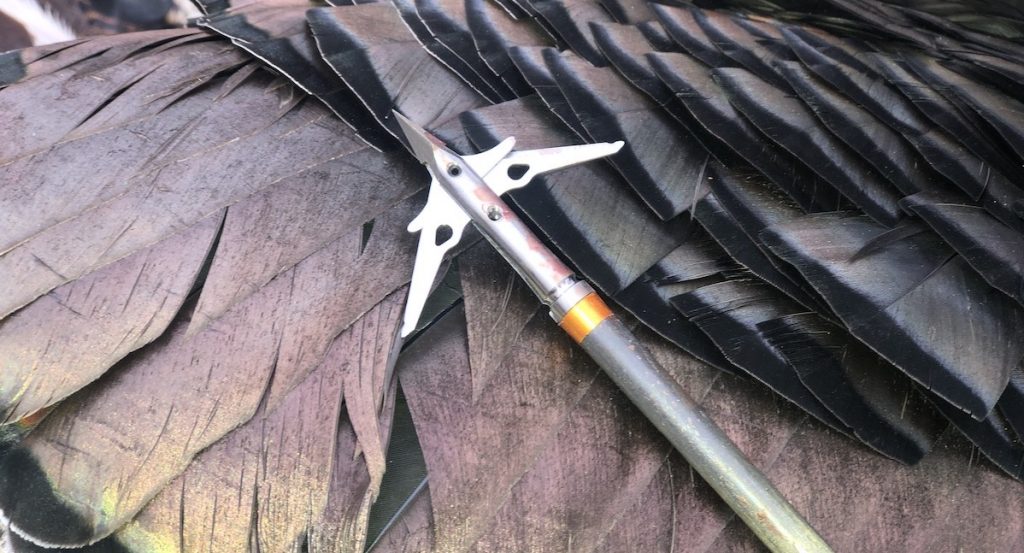
This is an Easton 6.5MM Bowhunter arrow I used years ago on a turkey hunt, and it worked well, but pay attention to how clean the SEVR Broadhead is.
Yes, those dense dark feathers can clog up a broadhead and seem like armor, but remember, you don’t need a ton of penetration to kill a turkey. I often prefer it if I don’t get a complete pass-through so the broadhead can stay in the bird and cause increased trauma. You want to cut a large hole, and because SEVR blades pivot as they pass through the animal, it’s more difficult for all those feathers to gum up on the blades. With vented fixed-blade broadheads, you’ll get loads of feathers pulled into the vents halting penetration, and you don’t get a large wound channel. If my life depended on killing a turkey with a bow and arrow and having that turkey expire within seconds, I’m shooting an Easton FMJ 4MM or 5MM tipped with a two-inch cut SEVR.
I geek out about making my arrows. There’s a sense of satisfaction that comes from it, and it gives one the knowledge they are making the most accurate arrow for their set-up. Shooting expandable broadheads, we don’t need to go down the straight, offset, or helical fletch rabbit hole. Bowhunting turkeys should be a close-range game, reducing the importance of the fletch number or orientation. What matters, though, is the fletching style. I want a low-profile fletch to steer my arrows with excellence and not grab a pile of feathers should the arrow pass through the bird. Tall vanes that are super stiff tend to collect massive globs of blood-soaked arrows. I also want a fletch system that welds the fletch to the arrow-like cement. If the fletch-to-arrow bond is weak, the nose of the fletch will lift, and gobs of feathers will slip in under it.
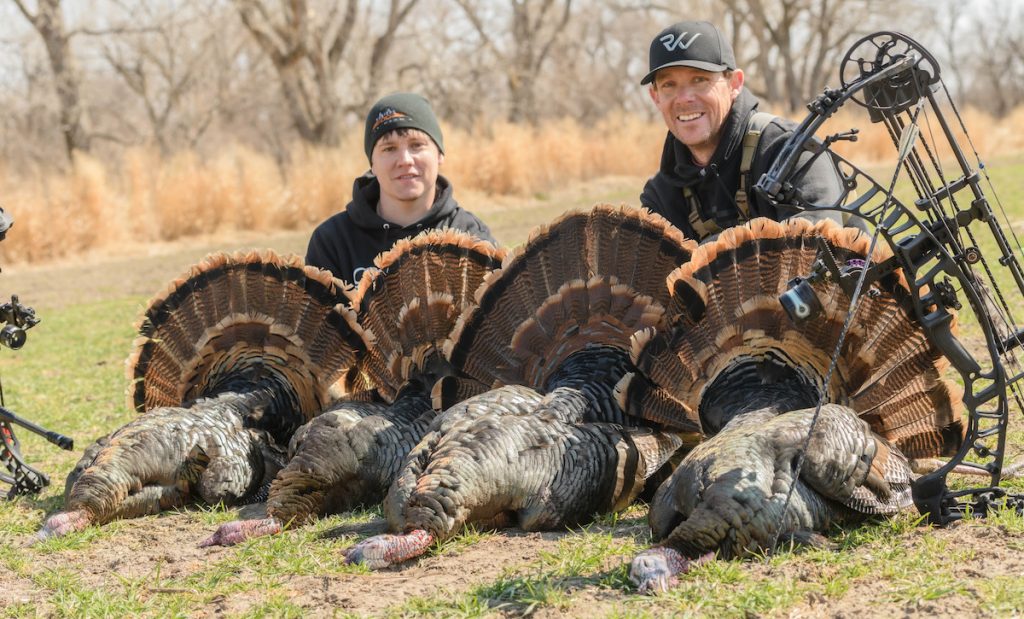
My fletch go-to, not only for turkeys but for all animals I bowhunt, is AAE’s Hybrid 23 vanes. Each vane measures 2.30 inches in length, has a height of .38 inches and weighs 5.7 grains. AAE’s Plastifletch “Lick & Stick” material with a factory-applied activator ensures great bonding when used in concert with AAE’s Maxweld Primer Pen and Max Bond Arrow Glue. The vane’s base is well-built, and I love the stabilization ridges that run horizontally along the vane. These ridges increase ease of fletch, boost durability, and aid in accuracy.
I’m always on the fence when it comes to lighted nocks. There are some good ones on the market and some poor makes. When shooting 4MM arrows, I usually avoid them as the ones I’ve shot snap easily where the nock and arrow meet. The X-size nock from Nocturnal, which would fit an Easton 5MM arrow, does work well, and I like how well the lighted nock shows up against a bird’s dark feathers. I’m more confident of my arrow’s impact when shooting a lighted nock.
Now for a little bonus section. One of the questions I get most is: “Where do I shoot a turkey with an arrow?” Great question. However, it depends on the bird’s position. Here’s my where-to-shoot a springtime noisemaker guide:
- Broadside – Whether the bird is in strut or not, divide his body into thirds. You want to be in the middle third and, if anything, toward the top of that third. Hit a tom low, and you’ll watch him go. My broadside aiming point is about two inches back from where the wing butt disappears into the body. Hit the bird here, and you get all the goodies.
- Quartering Toward – A quartering-toward shot is complex, and I typically wait for a full-frontal. However, if this is your shot, I try to put my arrow into the wing butt or slightly in front of it, about two inches to the quartering side of the bird’s beard. This will break the wing at the joint and give your arrow a good angle to catch other vital organs. Again, stay in the top third.
- Quartering Away – As with big-game animals, this shot is money. Remember to stay in the middle third, come up the back leg, and let your pin find the distinct line behind the wing and below the tail fan. This happens when the bird is in strut. Slide your arrow in this spot, and it’s game over.
- Full Frontal – This is my favorite shot on a turkey. Yes, it’s more marginal, but I know that if I do my job and execute it, it’s 100 percent lethal. Let your pin settle above the bird’s beard and start pushing and pulling.
- Facing Away – Take the Texas heart shot. You want to put your arrow right at the base of the fan feathers. If the bird isn’t in strut, hit him right in the middle of the back, halfway up the body.

This image shows perfect shot placement on a broadside bird. The arrow entered right behind the wing butt, and the bird expired in less than five seconds.
TIP: One of the best tips I can give to solve the “where” to shoot a turkey with an arrow conundrum is to get a 3-D target like Delta McKenzie’s Strutter Turkey. The target is inexpensive, and you can turn the full strut tom to any angle to improve your practice sessions.
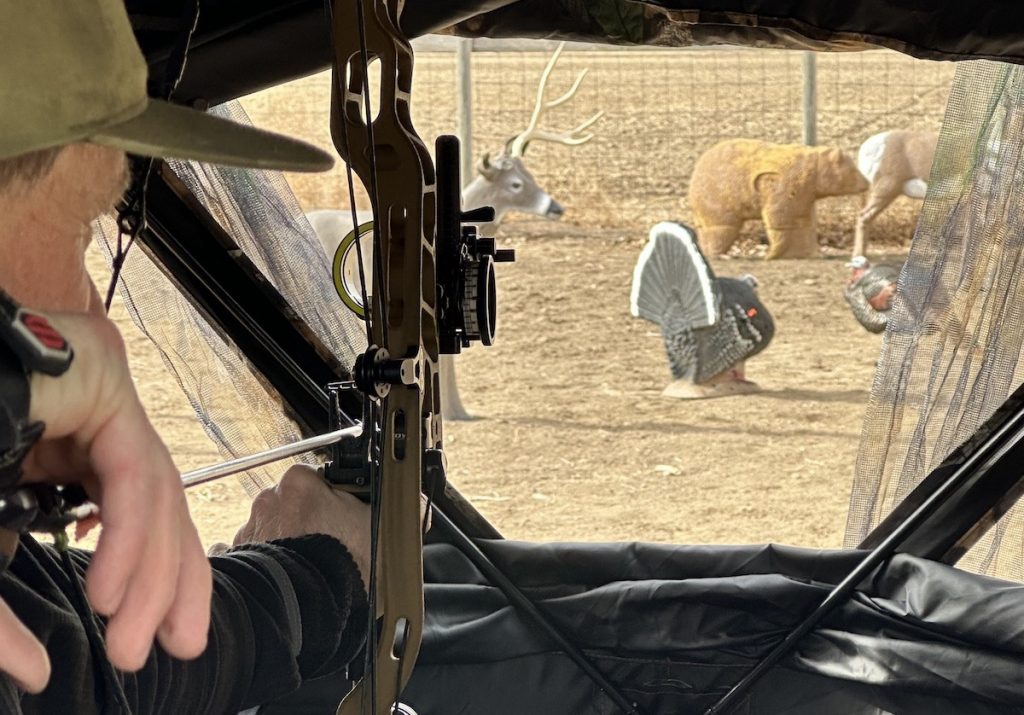
Bowhunting turkeys is super enjoyable and highly addictive. Heed the advice in this article, and you’ll bag more birds with archery gear this spring.
